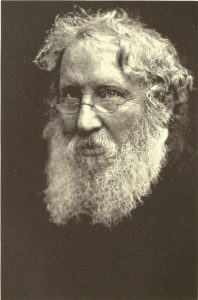Discovery and Acquisition
In 1947, a Bedouin shepherd by the name of Mohammed edh-Dhib from the Ta‘amireh tribe happened upon an opening to a cave while searching for a lost sheep in the Judean desert. He threw a stone into the cave and heard the sound of pottery shattering. Investigating further, he discovered seven pottery jars with almost complete scrolls encased in them. The shepherd and his friends, hoping to sell these scrolls, brought them to a shoemaker and antiquities dealer in Bethlehem by the name of Khalil Eskander Shahin (a.k.a. Kando).
Four of the scrolls discovered were sold by Kando to the Syrian Metropolitan, or Archbishop, Athanasius Yeshue Samuel of St. Mark’s Syrian Orthodox Church in Jerusalem. Three other scrolls were offered for sale to Prof. Eleazar Sukenik, archaeologist and professor at the Hebrew University. He recognized the scrolls as Second Temple texts and purchased them.
In January 1948, Sukenik was shown the other four scrolls. However, he was unable to organize their purchase before the strained relations between Arabs and Jews in the months leading up to the establishment of the State of Israel made the acquisition impossible. Instead, the Syrian Metropolitan took the scrolls to the American Schools of Oriental Research (ASOR) in East Jerusalem (now known as the Albright Institute) in order to consult with experts on their authenticity. The director of the Institute was away and the scrolls were instead shown to a graduate student named John Trever. Although he was unsure of their precise age, Trever recognized that the scrolls were ancient texts and photographed them in black and white. ASOR later published these manuscripts.
After the Israel War of Independence, Qumran, which had been part of the British Mandate of Palestine, passed into the hands of the Jordanians. The Jordanian Antiquities Authority managed to locate the cave where the scrolls had been discovered (known as Cave 1). In February 1949, G. Lancaster Harding, director of the Jordanian Antiquities Department, and Roland de Vaux of the École Biblique—the French biblical and archaeological school in Jerusalem—began to excavate the cave. After completing the task, they excavated the nearby ruins, known as Khirbet Qumran. They found coins and pottery linking the site to the scrolls and providing approximate dating for the scrolls.
Archaeologists did, of course, search the area for more scrolls, but found that they were competing with the Bedouin who recognized scroll discovery as an excellent source of income. The Bedouin discovered the majority of the scrolls, including the approximately 550 fragments discovered in Caves 4 and 6.
In 1954, the Syrian Metropolitan was still in possession of four large manuscripts. He was unwilling to sell to Israel for political reasons, but had been unable to attract a high enough price elsewhere. In desperation, he placed an advertisement in the Wall Street Journal on June 1, in which he suggested that the scrolls “would be an ideal gift to an educational or religious institution.”
Yigael Yadin, Israeli army general and archaeologist, was in the United States on a lecture tour at the time when the advertisement appeared. Yadin was the son of Prof. Sukenik, who had died before acquiring the scrolls. Yadin made arrangements to purchase the scrolls through an intermediary so that the Syrian Metropolitan would not be aware that he was selling them to the Israeli government. Before the purchase, Harry Orlinsky of Hebrew Union College–Jewish Institute of Religion in New York was sent to authenticate the scrolls using an assumed identity. The Israelis, with the help of American philanthropist D. S. Gottesman, purchased the scrolls for $250,000. Each of the four scrolls was flown on a separate plane to Israel, and all were placed in the Shrine of the Book at the Israel Museum, where they remain today.
In 1956, the Bedouin discovered Cave 11, which contained a number of important scrolls, including the Temple Scroll. In 1960, Reverend Joe Uhrig offered the Temple Scroll to Yigael Yadin. He supplied a small sample and received a $10,000 deposit in return. Yadin heard nothing from Uhrig after that transaction. During the Six-Day War in 1967, intelligence officers arrived at Kando’s home in Bethlehem and demanded he turn over the scroll. After the war, Kando was paid $108,000.
When Israeli soldiers captured East Jerusalem during the same war, they entered the Palestine Archaeological Museum and found the Dead Sea Scrolls intact. The museum, renamed the Rockefeller Museum to honor the contribution of the Rockefeller family to research of the scrolls, still houses a number of documents, including the Copper Scroll.
Primary Sources
Secondary Sources
- Discovery and Acquisition, 1947–1956, Lawrence H. Schiffman, Reclaiming the Dead Sea Scrolls, Jewish Publication Society, Philadelphia, 1994.
- Early Publication Efforts, 1953–1967, Lawrence H. Schiffman, Reclaiming the Dead Sea Scrolls, Jewish Publication Society, Philadelphia, 1994.
- First “Dead Sea Scroll” Found in Egypt Fifty Years Before Qumran Discoveries: Solomon Schechter presages later Essene scholarship, Raphael Levy, Biblical Archaeology Review (8:5), Sep/Oct 1982.
- The Dead Sea Scrolls and the People Who Wrote Them, Frank Moore Cross, Biblical Archaeology Review (3:1), Mar 1977.
- Yigael Yadin 1917–1984, Hershel Shanks, Biblical Archaeology Review (10:05), Sep/Oct 1984.
- Dead Sea Scrolls: A Short History, Hershel Shanks, Biblical Archaeology Review (33:03), May/Jun 2007.
- Past Perfect: Shall I Go to Bethlehem?, Yigael Yadin, Biblical Archaeology Review (33:3), May/June 2007.
- Excerpt from A Prophet Amongst You, Neil Asher Silberman, Addison-Wesley, Reading, 1993.
Images
Videos
Educational Resources
What do you want to know?
Ask our AI widget and get answers from this website
